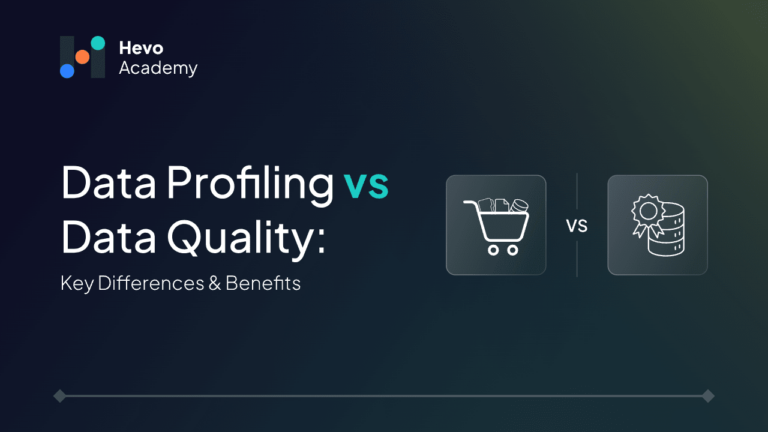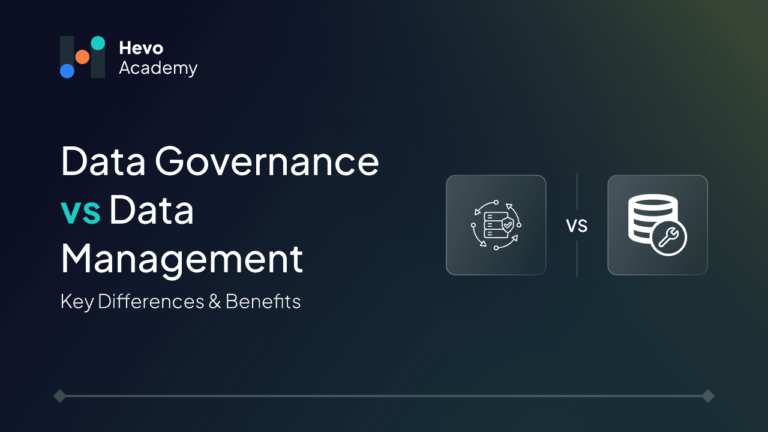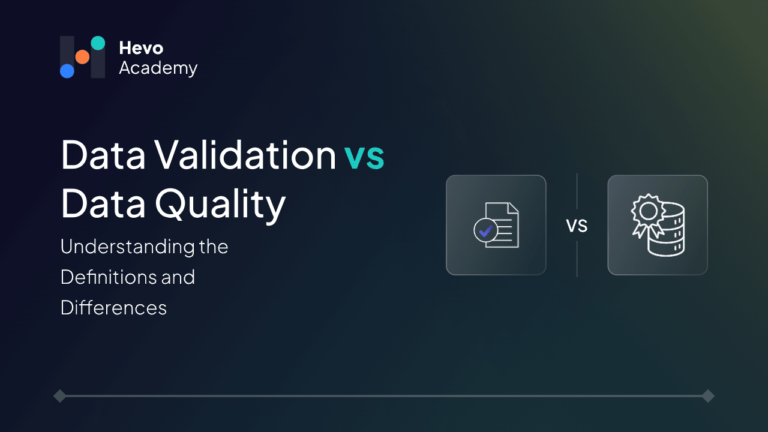In this data-driven world, organizations rely solely on data to make data-driven decisions; hence, the quality, accuracy, and reliability of the data are of the utmost importance. The two essential processes that play pivotal roles in achieving this are Data Profiling and Data Quality.
Table of Contents
Data Profiling vs Data Quality might look similar but they have different purposes in data management.
Data profiling analyzes data sets from various sources against market trends and identifies anomalies in the datasets by computing standard deviations and variations in the data. On the other hand, Data Quality mainly focuses on cleaning the data, maintaining data accuracy and consistency, and maintaining quality throughout the process.
In this blog, we’ll discuss the two data management processes, Data Profiling and Data Quality, and why they are crucial for organizations.
Data Profiling vs Data Quality: Tabular Difference
| Aspects | Data Profiling | Data Quality |
| Definition | Data Profiling is the process of analyzing the data structure, patterns, and anomalies. | Data Quality is the process of maintaining the quality of the data throughout the process by the use of pre-defined metrics to the data. |
| Objective | Data Profiling provides insights into the data before processing and helps to identify the issues within the data. | Data Quality focuses on maintaining the accuracy, completeness, and relevance of the data. |
| Process | Data Profiling is an exploratory activity. It is carried out at the beginning of the project, where the structure of the data is unknown. | Data Quality is a continuous process. Data Quality often uses the results of Data Profiling to determine the course of action that will make the data good. |
| Outcome | Data profiling provides statistical insights about the data. | Data Quality ensures that the data meets the standards and it is fit for the intended use. |
| Scope | Data profiling is typically carried out at the start of the project. | The Data Quality process is carried out throughout the data lifecycle. |
What is Data Profiling?
Data profiling is the process of analyzing datasets to understand their structure and gather statistics on them. It collects descriptive statistics (uniqueness, completeness, nulls) and metadata to evaluate the quality of the data and identify potential issues.
Data Profiling provides insights about the data, helping the organization uncover potential issues and potentially implement corrective measures in Data Quality.
Data Profiling is typically carried out at the start of the project when data is ingested from various sources. This helps businesses understand the data from various sources before moving with any data-intensive projects or pipelines.
Use Case of Data Profiling
The various use cases of Data Profiling in the industry are as follows –
- Data Profiling is often used in the Data Migration and Integration project before integrating data from multiple sources into a single system. Performing Data Profiling at this stage helps detect discrepancies like missing values, duplicates, or other inconsistencies.
- Profiling the database can identify redundant data models and data. This allows businesses to clean up their systems and improve overall database performance.
- Data Profiling can identify data compliance issues and highlight the areas where the policies aren’t entertained. This leads to better control over data access and usage.
- In ETL processes, data profiling helps to ensure that the data that is being extracted and transformed into the system is clean and ready before loading into a target system. This ensures that the transformation pipeline runs smoothly without interference.
- Data Profiling is often used in the BI process to ensure the data that’s being fed into BI tools is free from errors. Errors in the data can cause irrational statistics in the report.
- Data profiling at the Data Discovery phase helps in understanding the structure and content of data before it is used for analytics or machine learning models.
Hevo’s no-code platform simplifies your data management journey. With automated data pipelines and advanced transformation capabilities, Hevo ensures your data is accurate, consistent, and ready for decision-making.
- Automate data cleaning and transformation with ease
- The fault-tolerant architecture ensures no data is ever lost
- 150+ pre-built integrations allow data to be migrated in minutes
Ready to streamline your data management? Explore Hevo today!
Get Started with Hevo for FreeBenefits of Data Profiling
- Data profiling allows organizations to discover the actual content and quality of their data before the data is used in the data-intensive pipelines. This stage is crucial for an organization to make an informed, data-driven decision.
- Data Profiling helps organizations by identifying inaccuracies, anomalies, and incompleteness in the data. This minimizes the risks of poor decision-making due to unreliable data.
- Data profiling provides a comprehensive overview of the structure, relationships, and quality of data, thereby enabling organizations to make more informed data-driven decisions.
- Data profiling helps identify data, such as missing values, duplicates, and incorrect formats. This allows businesses to address the issues before the data is moved to the data pipeline.
What is Data Quality?
Data quality is a process of determining the data quality against pre-defined metrics to ensure that the data fits its intended purpose. Good data quality means that the data is accurate, complete, consistent, and relevant to the business.
Poor-quality data puts businesses at high risk as they make decisions based on incorrect or outdated information. This may lead to operational inefficiencies, customer dissatisfaction, and even legal penalties.
Data Quality is a continuous process and should be carried out at each pipeline level or where the data transformation takes place. This checks and ensures that the data after each transformation is of good quality and there isn’t any bad data.
Data quality is a continuous process of data monitoring, cleaning, and validating the data to maintain the organization’s standards. Data quality management is an ongoing process as opposed to data profiling, which is often done at the start of a project.
Use Cases of Data Quality
- Data Quality helps organizations ensure that their data is complete, accurate, and complies with legal standards. High-quality data minimizes the risk of non-compliance and the associated penalties.
- The financial sector often uses Data Quality to maintain the quality of its data, which is used to create accurate and compliant financial reporting. Errors in financial data can cause incorrect reporting, penalties, and damage to the business’s reputation.
- Nowadays, businesses rely on data-driven insights to make key decisions. High-quality data ensures that these insights are based on correct facts and not outdated information.
- High-quality data helps streamline business processes, such as inventory management, supply chain optimization, and financial reporting. Poor data quality can lead to inefficiencies and increased costs.
- High-quality data is required for BI purposes. Reliable and good-quality data is key to producing accurate insights and predictions. High-quality data ensures that business intelligence reports are trustworthy and actionable.
Benefits of Data Quality
- Good quality data helps in Informed Decision-Making. Higher-quality data leads to more accurate predictions and better business decisions.
- Poor data quality can lead to operational inefficiencies, which can thereby increase the associated costs like data reprocessing, incorrect decision-making, and data duplication.
- Good data quality helps organizations maintain their compliance with legal and industry regulations.
- Good data quality can provide better insights. With accurate and timely customer data, organizations can deliver personalized experiences. This helps in achieving higher customer satisfaction and loyalty.
How Can Profiling Data Help Data Quality?
Data profiling and Data Quality go hand in hand. Data Profiling plays a crucial role in improving the quality of the data. By analyzing the profiling results, organizations can take measurable steps to clean, validate, and organize data.
Below are a few specific ways in which data profiling helps improve data quality:
- Detecting Data Anomalies: Data Profiling identifies outliers, missing values, and incorrect data formats. These can be fixed in the data quality process to improve the data quality.
- Understanding Data Distribution: Data Profiling discovers patterns in data, which helps data engineers design better data cleaning and transformation pipelines.
- Data Redundancies: Data Profiling highlights the redundant data entries and duplicate records, which can be eliminated in the data quality stage to ensure data consistency and accuracy.
- Improving Data Completeness: Data Profiling can help organizations determine if key attributes are missing or incomplete. Preventive measures can be taken to fill these gaps.
- Validation of Data Sources: Data Profiling ensures that data coming from various sources are reliable and trustworthy by comparing expected data patterns to actual data.
Data Profiling Best Practices
- Automating the profiling pipeline allows faster and more continuous analysis of large data sets. When the analysis is completed, it can provide comprehensive insights into data patterns, structures, and anomalies.
- Data Profiling rules should be aligned with the specific data quality requirements of the organizations.
- Data profiling is an iterative process, and it has to be carried out for each and every source system whenever they send the data. By conducting the data profiling regularly and at continuous intervals, organizations can stay on top of any new issues that arise over time.
- Data Profiling can be integrated with the ETL (Extract, Transform, Load) pipelines to ensure that the data ingested is profiled in real-time.
- Involving the technical and business stakeholders in the data profiling process helps capture comprehensive insights into the data.
Data Quality Best Practices
- Good metrics can define what “good” data looks like. A metric that measures the accuracy, completeness, consistency, and timeliness of the data makes it reliable for use.
- Automating the Data Cleansing process, such as duplicate removal and standardizing formats, ensures that the data is always accurate.
- Documentation and training on the Data Quality framework are important for businesses as well as technical stakeholders.
- Continuous monitoring of data quality helps determine issues as and when they arrive. Triggers help send notifications when issues are detected.
- Standard data entry practices should be implemented across organizations. This will ensure that the data is consistent and accurate.
Conclusion
In the world of data management, Data Profiling and Data Quality are two sides of the same coin. Both Data profiling and Data Quality are important aspects of effective data management.
Data profiling provides insights into the structure and completeness of data, whereas Data Quality ensures that the data is accurate, consistent, and fit for use.
Together, these two processes form the backbone of any organization, thereby helping businesses achieve operational excellence, regulatory compliance, and superior decision-making.
Schedule a personalized demo with Hevo for effortless data integration.
FAQs
1. What are the three pillars of data governance?
The three pillars of data governance are data quality, data management, and data privacy/security.
2. What are examples of data governance?
Examples of data governance include applying policies to access the data, establishing and maintaining data quality standards, and ensuring compliance with regulations like GDPR.
3. What is data governance assessment?
A data governance assessment evaluates an organization’s data governance practices, measuring how well data is managed, how good the data quality is, and whether compliance policies are implemented.






